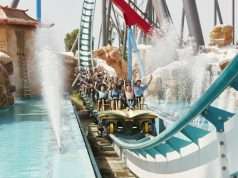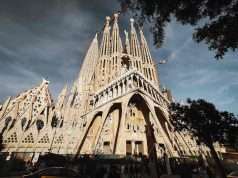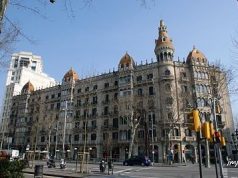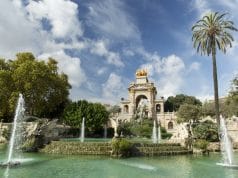In 1992 all eyes around the world were on Barcelona for the olympic games. The main stadium still stands and can be visited. A great place for all fans of sport.
If you are a fan of sports, history, or architecture, you should pay a visit to the Barcelona Olympic Stadium. It is also known as Estadi Olímpic Lluís Companys. This impressive venue has hosted some of the most memorable events in the city’s history. Such as the 1929 International Exposition to the 1992 Summer Olympics and Paralympics. In this post, I will tell you more about the history of the stadium, how to get there, and what to see and do nearby.
The History of the Barcelona Olympic Stadium
The Barcelona Olympic Stadium was built in 1927 by architect Pere Domènech i Roura. It was built for the 1929 International Exposition in Barcelona. It was originally named Estadio de Montjuic, after the hill where it is located. The stadium was intended to host the People’s Olympiad in 1936, a protest event against the Nazi Olympics in Berlin. This was canceled due to the outbreak of the Spanish Civil War.
It was renovated in 1985-89 by Italian architect Vittorio Gregotti for the 1992 Summer Olympics and Paralympics. It was renamed Estadi Olímpic de Montjuïc and later Estadi Olímpic Lluís Companys, after a Catalan politician who was executed by Franco’s regime. The stadium hosted the opening and closing ceremonies and all the athletics competitions of the Olympic Games and Paralympics. Some of the most memorable moments include the lighting of the Olympic cauldron by archer Antonio Rebollo, who shot a flaming arrow over the stadium; the gold medal of Carl Lewis in the long jump; and the world record of Kevin Young in the 400 meters hurdles.
Barcelona Olympic stadium has also hosted other sporting events, such as football matches, rugby games, and motor racing. It was the home ground of RCD Espanyol from 1997 to 2009. It will be the home stadium of FC Barcelona for the 2023-24 season due to the renovation of their regular ground, Camp Nou. The stadium has also hosted concerts by famous artists such as Beyoncé, Harry Styles, and The Weeknd.
There is a capacity for 60,000 spectators and the stadium features a distinctive elliptical shape, a large esplanade, and a monumental tower. The main olympic stadium is surrounded by other Olympic facilities, such as the Palau Sant Jordi, the Sant Jordi Club, the Picornell swimming pools, and the Olympic Museum.
Concerts That Have Been Held At Barcelona Olympic Stadium
Since its inauguration, the stadium has hosted some of the most important sporting events in the world, such as the opening and closing ceremonies of the 1992 Olympics, the 1999 World Athletics Championships, the 2003 World Swimming Championships, and several matches of the 1982 FIFA World Cup and the 1992 UEFA European Championship.
The Barcelona Olympic Stadium has also been a venue for some of the most famous and diverse musical acts, such as The Rolling Stones, Bruce Springsteen, David Bowie, U2, Madonna, Beyoncé, Michael Jackson, Tina Turner, Coldplay, Rammstein, and Depeche Mode, among many others. The stadium has also welcomed other cultural and social events, such as the MTV Europe Music Awards, the Cirque du Soleil, and the Global Citizen Festival.

How to Get to the Barcelona Olympic Stadium
You will find that the Barcelona Olympic Stadium is located in the Anella Olímpica (Olympic Ring). This is within a complex of sports facilities and parks on Montjuïc hill. The easiest way to get there is by public transport. You can take the metro line L1 or L3 to Plaça Espanya and then walk for about 15 minutes. If you prefer you can take bus number 150. You can also take the funicular from Paral·lel station to Montjuïc and then walk for about 10 minutes or take bus number 55. Alternatively, you can take a taxi or a bike to get there.
You can visit from Monday to Sunday from 8:00 am to 8:00 pm. The entrance fee is 5 euros for adults and 3 euros for children under 12 years old. You can buy tickets online or at the ticket office at the stadium. You can also book a guided tour of the stadium for 10 euros per person.
What to See and Do Near the Olympic Stadium
The Olympic Stadium doesn’t stand alone, and close by are some of Barcelona’s cultural and natural attractions. Here are some of them close to the stadium:
- The Palau Sant Jordi, a multi-purpose arena that hosted gymnastics, volleyball, handball, and basketball during the Olympics. It also hosts concerts and shows throughout the year.
- The Torre Calatrava, a futuristic tower that served as a communications antenna during the Olympics. It was designed by Spanish architect Santiago Calatrava and inspired by a human body holding an Olympic torch.
- The Museu Olímpic i de l’Esport Joan Antoni Samaranch, a museum that showcases the history and values of Olympism and sport. It has interactive exhibits, memorabilia, videos, and a hall of fame.
- The Jardins de Joan Maragall, a beautiful park that surrounds the Palauet Albéniz, a royal residence that hosted the Olympic family during the Games. It has fountains, sculptures, and flowers.
- The Castell de Montjuïc, a 17th-century fortress that offers panoramic views of the city and the sea. It was used as a military prison and a museum until 2007. Now it is a cultural center that hosts exhibitions and events.
- The Fundació Joan Miró, a museum that displays the works of Catalan artist Joan Miró, one of the most influential figures of modern art. It has paintings, sculptures, drawings, and ceramics by Miró and other artists.
As you can see, the Olympic Stadium in Barcelona is more than just a stadium. It is a symbol of the city’s history, culture, and spirit. If you are planning to visit Barcelona, don’t miss the opportunity to see it for yourself. Don’t forget that the Montjuïc area has many other attractions to visit. If you plan to visit the Barcelona Olympic Stadium, make sure you visit some of the other sights and attractions.













